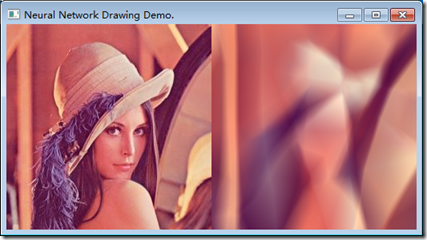1.先放置一张要绘制的图片(本例使用图像处理的经典图片lina)
2.ImageDrawer.java(不断的根据坐标值,调整输出的RGB值)
package com.jiantsing.test;
import javafx.application.Application;
import javafx.application.Platform;
import javafx.scene.Scene;
import javafx.scene.image.*;
import javafx.scene.layout.HBox;
import javafx.scene.paint.Color;
import javafx.stage.Stage;
import org.deeplearning4j.nn.api.OptimizationAlgorithm;
import org.deeplearning4j.nn.conf.MultiLayerConfiguration;
import org.deeplearning4j.nn.conf.NeuralNetConfiguration;
import org.deeplearning4j.nn.conf.Updater;
import org.deeplearning4j.nn.conf.layers.DenseLayer;
import org.deeplearning4j.nn.conf.layers.OutputLayer;
import org.deeplearning4j.nn.multilayer.MultiLayerNetwork;
import org.deeplearning4j.nn.weights.WeightInit;
import org.nd4j.linalg.activations.Activation;
import org.nd4j.linalg.api.ndarray.INDArray;
import org.nd4j.linalg.dataset.DataSet;
import org.nd4j.linalg.factory.Nd4j;
import org.nd4j.linalg.lossfunctions.LossFunctions;
/**
* JavaFX application to show a neural network learning to draw an image.
* Demonstrates how to feed an NN with externally originated data.
*
* This example uses JavaFX, which requires the Oracle JDK. Comment out this example if you use a different JDK.
* OpenJDK and openjfx have been reported to work fine.
*
* TODO: sample does not shut down correctly. Process must be stopped from the IDE.
*
* @author Robert Altena
*/
public class ImageDrawer extends Application {
private Image originalImage; //The source image displayed on the left.
private WritableImage composition; // Destination image generated by the NN.
private MultiLayerNetwork nn; // THE nn.
private DataSet ds; //Training data generated (only once) from the Original, used to train.
private INDArray xyOut; //x,y grid to calculate the output image. Needs to be calculated once, then re-used.
/**
* Training the NN and updating the current graphical output.
*/
private void onCalc(){
nn.fit(ds);//训练神经网络
drawImage();//再次输出测试
Platform.runLater(this::onCalc);
}
@Override
public void init(){
// originalImage = new Image("/DataExamples/Mona_Lisa.png");
originalImage = new Image("/images/lina.jpg");
final int w = (int) originalImage.getWidth();
final int h = (int) originalImage.getHeight();
composition = new WritableImage(w, h); //Right image.
ds = generateDataSet(originalImage);
nn = createNN();
// The x,y grid to calculate the NN output only needs to be calculated once.
int numPoints = h * w;
xyOut = Nd4j.zeros(numPoints, 2);//坐标输入矩阵
for (int i = 0; i < w; i++) {
double xp = (double) i / (double) (w - 1);
for (int j = 0; j < h; j++) {
int index = i + w * j;//0----w*h-1,用行下标表示所有的点阵
double yp = (double) j / (double) (h - 1);
xyOut.put(index, 0, xp); //2 inputs. x and y.,x坐标,double表示便于计算
xyOut.put(index, 1, yp);//y坐标,double表示便于计算
}
}
// System.out.println(xyOut);
drawImage();//此时未调用神经网络,未开始训练
}
/**
* Standard JavaFX start: Build the UI, display
*/
@Override
public void start(Stage primaryStage) {
final int w = (int) originalImage.getWidth();
final int h = (int) originalImage.getHeight();
final int zoom = 1; // Our images are a tad small, display them enlarged to have something to look at.
ImageView iv1 = new ImageView(); //Left image
iv1.setImage(originalImage);
iv1.setFitHeight( zoom* h);
iv1.setFitWidth(zoom*w);
ImageView iv2 = new ImageView();
iv2.setImage(composition);
iv2.setFitHeight( zoom* h);
iv2.setFitWidth(zoom*w);
HBox root = new HBox(); //build the scene.
Scene scene = new Scene(root);
root.getChildren().addAll(iv1, iv2);
primaryStage.setTitle("Neural Network Drawing Demo.");
primaryStage.setScene(scene);
primaryStage.show();
Platform.setImplicitExit(true);
//Allow JavaFX do to it's thing, Initialize the Neural network when it feels like it.
Platform.runLater(this::onCalc);
}
public static void main( String[] args )
{
launch(args);
}
/**
* Build the Neural network.
*/
private static MultiLayerNetwork createNN() {
int seed = 2345;
int iterations = 25; //<-- Just the one iteration per call to fit.
double learningRate = 0.1;
int numInputs = 2; // x and y.,坐标输入
int numHiddenNodes = 25;
int numOutputs = 3 ; //R, G and B value.,颜色输出
MultiLayerConfiguration conf = new NeuralNetConfiguration.Builder()
.seed(seed)
.iterations(iterations)
.optimizationAlgo(OptimizationAlgorithm.STOCHASTIC_GRADIENT_DESCENT)
.learningRate(learningRate)
.weightInit(WeightInit.XAVIER)
.updater(Updater.NESTEROVS).momentum(0.9)
.list()
.layer(0, new DenseLayer.Builder().nIn(numInputs).nOut(numHiddenNodes)
.activation(Activation.IDENTITY)
.build())
.layer(1, new DenseLayer.Builder().nIn(numHiddenNodes).nOut(numHiddenNodes)
.activation(Activation.RELU)
.build())
.layer(2, new DenseLayer.Builder().nIn(numHiddenNodes).nOut(numHiddenNodes)
.activation(Activation.RELU)
.build())
.layer(3, new DenseLayer.Builder().nIn(numHiddenNodes).nOut(numHiddenNodes)
.activation(Activation.RELU)
.build())
.layer(4, new OutputLayer.Builder(LossFunctions.LossFunction.L2)
.activation(Activation.IDENTITY)
.nIn(numHiddenNodes).nOut(numOutputs).build())
.pretrain(false).backprop(true).build();
MultiLayerNetwork net = new MultiLayerNetwork(conf);
net.init();
return net;
}
/**
* Process a javafx Image to be consumed by DeepLearning4J
*
* @param img Javafx image to process
* @return DeepLearning4J DataSet.
*/
private static DataSet generateDataSet(Image img) {
int w = (int) img.getWidth();
int h = (int) img.getHeight();
int numPoints = h * w;
PixelReader reader = img.getPixelReader();
INDArray xy = Nd4j.zeros(numPoints, 2);//输入
INDArray out = Nd4j.zeros(numPoints, 3);//答案
//Simplest implementation first.
for (int i = 0; i < w; i++) {
double xp = (double) i / (double) (w - 1);
for (int j = 0; j < h; j++) {
Color c = reader.getColor(i, j);
int index = i + w * j;//0----w*h-1,用行下标表示所有的点阵
double yp = (double) j / (double) (h - 1);
xy.put(index, 0, xp); //2 inputs. x and y.
xy.put(index, 1, yp);
out.put(index, 0, c.getRed()); //3 outputs. the RGB values.
out.put(index, 1, c.getGreen());
out.put(index, 2, c.getBlue());
}
}
return new DataSet(xy, out);
}
/**
* Make the Neural network draw the image.
*/
private void drawImage() {
int w = (int) composition.getWidth();
int h = (int) composition.getHeight();
// System.out.println(xyOut);
INDArray out = nn.output(xyOut);//根据坐标矩阵,计算颜色输出矩阵
PixelWriter writer = composition.getPixelWriter();
for (int i = 0; i < w; i++) {
for (int j = 0; j < h; j++) {
int index = i + w * j;
double red = capNNOutput(out.getDouble(index, 0));//capNNOutput转化时必须>=0,<=1
double green = capNNOutput(out.getDouble(index, 1));
double blue = capNNOutput(out.getDouble(index, 2));
Color c = new Color(red, green, blue, 1.0);
writer.setColor(i, j, c);
}
}
}
/**
* Make sure the color values are >=0 and <=1
*/
private static double capNNOutput(double x) {
double tmp = (x<0.0) ? 0.0 : x;
return (tmp > 1.0) ? 1.0 : tmp;
}
}
3.效果图(运行起来有点卡,左边原图,右边电脑绘制,运行越久越逼真)
























 112
112

 被折叠的 条评论
为什么被折叠?
被折叠的 条评论
为什么被折叠?








